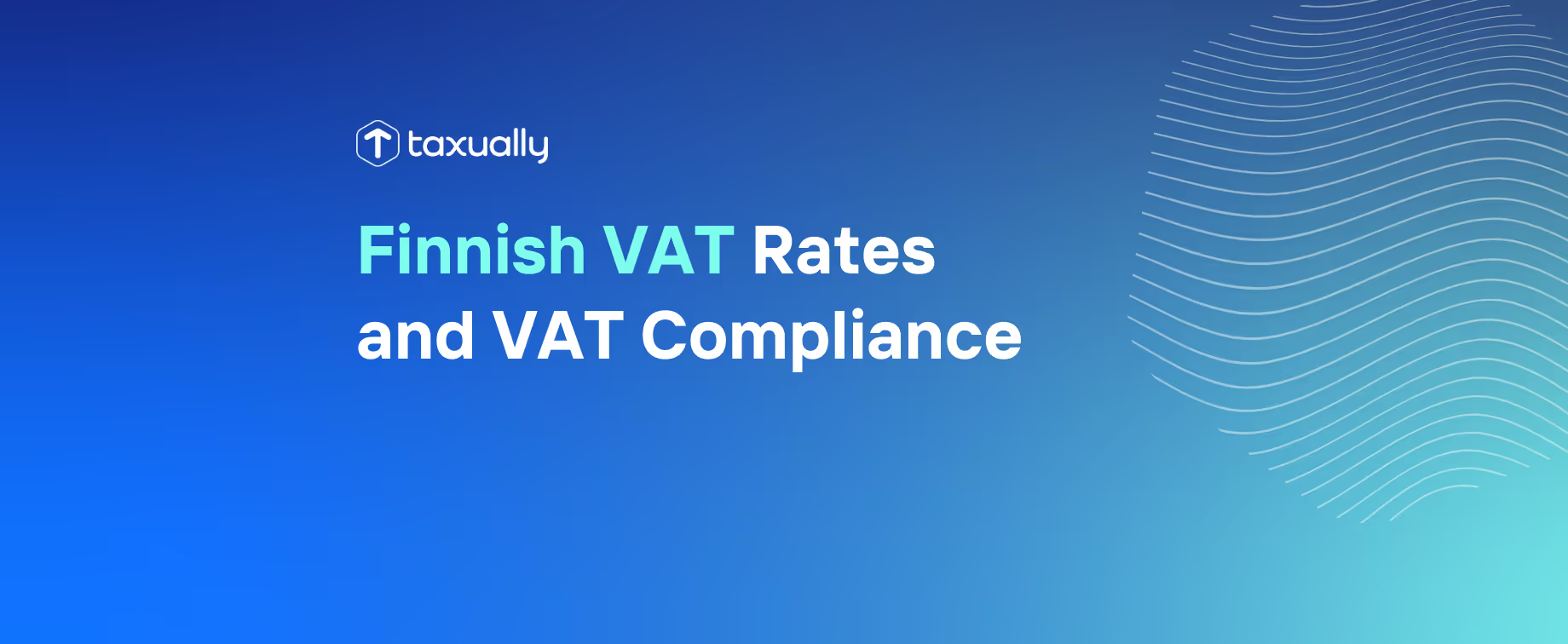Key takeaways
- The Finnish VAT landscape includes a 24% standard rate and two reduced rates, with businesses required to understand these rates for compliance.
- Businesses must register for VAT if taxable turnover exceeds €15,000. Companies distance selling in Finland must register once their taxable turnover exceeds €10,000.
- International consumer sales up to €150 can be registered under the IOSS scheme. Intrastat declarations are essential for EU trading activities.
Understanding the intricacies of the Finnish VAT system, including the VAT rate in Finland, is crucial to ensure compliance. Here, we will explore the various VAT rates, registration requirements, compliance, and invoicing procedures in Finland, shedding light on the unique aspects of the Finnish VAT landscape that businesses need to be aware of.
Finnish VAT rates overview
The Finnish VAT system consists of a standard VAT rate of 24% and two reduced rates applicable to specific goods and services as well as sales to non-profit corporations. These rates are defined by the Finnish VAT Act and are designed to accommodate the diverse range of products and services available in the market.
Businesses must familiarize themselves with these diverse VAT rates to comply with Finnish tax legislation.
Standard VAT rate
The standard VAT rate in Finland is 24%, which is applicable to the majority of goods and services. This rate is higher than the EU average of 21%, making Finland the fifth highest among the EU Member States in terms of standard VAT rate.
Reduced VAT rates
Finland offers two reduced VAT rates:
- The 14% reduced rate applies to groceries, takeaway food, and restaurant and catering services, excluding alcoholic beverages and tobacco products.
- The 10% reduced rate applies to books, newspapers, pharmaceuticals, accommodation services, and passenger transport.
There is also a 0% rate that applies to certain goods and services, such as exports, and international transport.
VAT Exemptions
VAT exemptions in Finland typically include financial and insurance services, as well as healthcare and education. These exemptions help maintain affordability and accessibility in essential sectors.
VAT thresholds and registration

In Finland, the VAT registration threshold is set at €15,000 for businesses based in the country, meaning that companies with a taxable turnover exceeding this amount are required to register for VAT.
Foreign businesses that distance sell to customers in Finland are required to register for VAT and charge Finnish VAT on their sales to Finnish customers once their annual sales exceed €10,000.
The registration process involves submitting a notification to the electronic tax administration service MyTax.
Businesses can voluntarily register for VAT in Finland even if their taxable turnover falls below the relevant threshold. Voluntary registration can be beneficial for businesses that often purchase goods or services subject to VAT, enabling them to claim input VAT on these purchases.
VAT compliance and invoicing
Businesses need to follow Finnish VAT compliance and invoicing requirements to prevent potential fines, penalties, or legal repercussions. In Finland, a VAT invoice serves as the official record of the amount of tax a business has charged and collected, as well as the evidence of the amount of tax they are liable to pay to the government.
VAT invoices must be issued for all taxable supplies, and the VAT identification number must be prominently displayed on all invoices issued to customers. The precise particulars necessary for a VAT invoice in Finland are specified by the Finnish Tax Administration.
Invoicing requirements
Finnish VAT invoicing requirements mandate that VAT-registered businesses provide VAT invoices for all taxable supplies and include the amount of VAT being charged and other relevant information on the invoice. VAT invoices in Finland must contain the following information:
- The word 'Lasku' (invoice) clearly marked on the document.
- A unique, sequential invoice number.
- The seller's and buyer's full legal names and addresses.
- The seller's VAT identification number.
- The date of issuance of the invoice.
- A description of the goods or services provided, including quantity, unit price, and the applicable VAT rate.
- The total amount due, including the VAT amount, broken down by VAT rate.
- If the invoice amount is denominated in a foreign currency, the exchange rate used must be indicated.
- If applicable, information about any VAT-exempt transactions or reverse charge mechanisms.
- The date of supply or the date of advance payment (if different from the invoice date).
Finland encourages the use of electronic invoicing, which must meet specific requirements and be transmitted in a structured format.
Record-keeping
Maintaining accurate records is a fundamental aspect of VAT compliance. Businesses must keep records of all their transactions, including invoices, receipts, and other relevant documents for 10 years in accordance with Finnish VAT regulations. This ensures businesses can report their VAT liabilities correctly.
Filing VAT returns and deadlines
Filing VAT returns and meeting deadlines is vital for businesses in Finland to maintain compliance and avoid penalties. VAT returns can be filed monthly, quarterly, or yearly, depending on the business’s turnover and VAT registration status.
Monthly and quarterly VAT returns must be submitted by the 12th day of the second month following the conclusion of the tax Finland period, while yearly returns must be submitted by the end of February of the following year. Failure to submit VAT returns on time could result in penalties of €3 per day, up to a maximum of €135, provided the delay does not exceed 45 days.
VAT returns and other declarations can be submitted online in Finland through the MyTax portal. The MyTax portal is an e-service the Tax Administration provides that enables individuals and businesses to manage their tax Finland matters online. To submit VAT returns and EU VAT Recapitulative Statements, businesses must access the MyTax portal using online banking codes, a mobile certificate, or the Finnish Authenticator app. Paper form submissions are no longer accepted.
Fiscal representatives

Companies that are not established in the EU but are engaged in taxable activities in Finland are required to appoint a fiscal representative for VAT registration.
A fiscal representative in Finland for VAT purposes is a person or entity appointed by a non-EU company to fulfill the company’s obligations with the Finnish tax authorities. The fiscal representative acts as the local agent of the foreign trader and is responsible for performing tasks such as VAT registration, verification of invoices and documents, and liaising with the tax authorities on behalf of the company.
Fiscal representatives must be domiciled in Finland and approved by the Regional Tax Office.
EU VAT and the One-Stop-Shop (OSS)
Introduced in July 2021, the One-Stop-Shop (OSS) system allows centralized VAT reporting for international consumer sales in Finland. The OSS enables businesses to register in one EU country and report all their pan-EU distance sales on a single VAT return, simplifying the VAT reporting process. This system provides numerous advantages for businesses, such as cost efficiency, simpler administration of VAT, and enhanced customer experience with price visibility and cost assurance.
IOSS for international consumer sales
With the Import One-Stop-Shop (IOSS), also introduced in July 2021, businesses outside the EU can register for a single VAT identification number in an EU member state, allowing them to collect and remit VAT on low-value goods (under €150) sold to EU consumers. This streamlines the customs process, reducing delays and costs, and makes it easier for consumers to purchase goods online, while ensuring proper VAT compliance.
Intrastat Declarations
Intrastat declarations are required for businesses trading within the EU. These declarations are used to gather data on intra-EU trade, which assists in the compilation of trade statistics.
In Finland, Intrastat declarations must be submitted by the 10th day of the month following the reporting period. The Intrastat thresholds are €800,000 for dispatches and €800,000 for arrivals.
Conclusion
After reading this guide, you should have a clearer understanding of VAT rates, registration requirements, compliance, and invoicing procedures in Finland. By staying informed and up-to-date on these important aspects of the Finnish VAT landscape, your business can ensure compliance, avoid potential fines and penalties, and ultimately, thrive in the Finnish market.
Do you need help with your VAT compliance? Book a free call with one of our VAT experts to find bespoke solutions for your business, optimize your VAT costs, and reach millions of new potential customers.
Frequently asked questions
New Year's Day - 1/1/2024Memorial Day - 5/27/20244th of July - 7/4/2024Labor Day - 9/2/2024Thanksgiving Day - 11/28/2024Day after Thanksgiving - 11/29/2024Christmas Eve - 12/24/2024Christmas Day - 12/25/2024
Is Finland VAT 24%?
Yes, Finland has a VAT rate of 24%, with some goods and services subject to 14% and 10% reduced rates.
Is Finland part of the EU for VAT?
Finland is a member of the EU and must adhere to EU VAT Directives, which includes setting the minimum standard VAT rate at 15%. Finland is part of the EU's single market economy and has to implement its rules for Finnish VAT registrations, returns, Intrastat, compliance, and related declarations.
How can I register for VAT in Finland?
Businesses can register for VAT in Finland via MyTax, the electronic tax administration service.



















